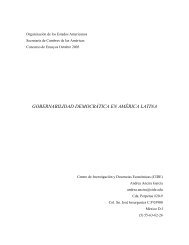The Road to Hemispheric Cooperation: Beyond the Cartagena
The Road to Hemispheric Cooperation: Beyond the Cartagena
The Road to Hemispheric Cooperation: Beyond the Cartagena
Create successful ePaper yourself
Turn your PDF publications into a flip-book with our unique Google optimized e-Paper software.
Technology and Innovation<br />
Innovation is one of <strong>the</strong> keys <strong>to</strong> diversifying production.<br />
Broadly defined, it includes not only radical changes but<br />
also small improvements in product design and quality, in<br />
<strong>the</strong> production process and its organization, and in marketing<br />
and logistics. This process, in turn, is a function of<br />
three things: capacities <strong>to</strong> create, learn and adapt knowledge<br />
and techniques <strong>to</strong> <strong>the</strong> productive and commercial domain;<br />
possibilities for capturing <strong>the</strong> greatest value added<br />
by those innovations; and <strong>the</strong> availability of <strong>the</strong> material,<br />
human and financial resources required. 5 <strong>The</strong> greater <strong>the</strong><br />
generation of knowledge and linkages with <strong>the</strong> rest of <strong>the</strong><br />
production structure, <strong>the</strong> greater <strong>the</strong> impact of innovation<br />
on productivity and growth.<br />
As <strong>the</strong> experience of developed countries shows, <strong>the</strong> main<br />
driving force for innovation comes from <strong>the</strong> interaction between<br />
research and development (R&D) activities (both<br />
public and private) and <strong>the</strong> capacity of firms <strong>to</strong> generate,<br />
adopt and disseminate innovative processes and products.<br />
On <strong>the</strong> o<strong>the</strong>r hand, in developing economies, learning<br />
consists of increasing <strong>the</strong> adoption and adaptation of<br />
innovations in all activities related <strong>to</strong> production processes,<br />
product quality, and design and commercialization strategies.<br />
This develops <strong>the</strong> countries’ technological capabilities<br />
and generates competitive advantages that redefine <strong>the</strong> export<br />
potential of businesses and <strong>the</strong> international position of<br />
each economy.<br />
<strong>The</strong> difference between <strong>the</strong> speed of innovation in <strong>the</strong> leading<br />
countries and <strong>the</strong> speed with which <strong>the</strong> less-developed<br />
countries succeed in learning, imitating and adapting is<br />
crucial for <strong>the</strong> types of participation both have in <strong>the</strong> international<br />
economy. Falling behind may have long-term<br />
consequences for competitiveness and growth. As several<br />
studies show, <strong>the</strong>re is a virtuous cycle in which R&D spending,<br />
innovation, productivity and per capita income mutually<br />
reinforce each o<strong>the</strong>r. 6<br />
Technology: A Few Highlights<br />
As ECLAC has pointed out, scientific and technological<br />
capabilities in LAC countries are mixed, with important<br />
asymmetries and lags. As Table 1 indicates, investment<br />
in R&D in Latin American countries, with <strong>the</strong> exception of<br />
Brazil, is lower than expected, given <strong>the</strong> level of per capita<br />
income. Spending on R&D barely exceeds 0.5 percent of<br />
GDP in <strong>the</strong> region, which is one-quarter of <strong>the</strong> world average<br />
and below <strong>the</strong> figures for China, India and Malaysia.<br />
Most of <strong>the</strong> region’s limited investments in R&D are governmental<br />
in origin, while <strong>the</strong> contribution of businesses is<br />
much lower. <strong>The</strong> opposite is true in more advanced countries:<br />
public resources are supplemented by a higher level<br />
of business investment in R&D.<br />
<strong>The</strong> number of researchers per million inhabitants in <strong>the</strong><br />
region is around one-tenth of <strong>the</strong> number observed in developed<br />
countries. However, <strong>the</strong> region does not fare <strong>to</strong>o<br />
poorly when this indica<strong>to</strong>r is compared with <strong>the</strong> results in<br />
some o<strong>the</strong>r developing countries such as China, India and<br />
Malaysia. Also, when comparing <strong>the</strong> number of patent applications<br />
with o<strong>the</strong>r emerging countries, <strong>the</strong> region still<br />
lags behind in terms of efforts <strong>to</strong> adopt and create new<br />
technologies. China in particular has successfully imitated<br />
and adapted new technologies <strong>to</strong> create its own technological<br />
capacity.<br />
Innovation patterns are asymmetrical. Most R&D activities<br />
in LAC are geared <strong>to</strong>ward science and basic research;<br />
in countries at <strong>the</strong> cutting edge of technology, R&D is focused<br />
on applied and experimental development. Also,<br />
R&D in <strong>the</strong> region occurs mainly in public labora<strong>to</strong>ries and<br />
universities, while in o<strong>the</strong>r regions it is carried out chiefly<br />
by businesses.<br />
As <strong>the</strong> experience of advanced countries shows, investment<br />
in R&D increases as <strong>the</strong> economy becomes specialized<br />
in more complex scientific and technological<br />
sec<strong>to</strong>rs and activities. A relatively small proportion of <strong>the</strong><br />
increase comes from government. Public-sec<strong>to</strong>r participation<br />
is a fundamental component of <strong>the</strong> first innovation<br />
phase in countries that have successfully built <strong>the</strong>ir<br />
own technological capacity, allowing <strong>the</strong>m <strong>to</strong> advance<br />
from adapting technology <strong>to</strong> creating it. Since most LAC<br />
countries are at this first stage, <strong>the</strong> most worrying aspect<br />
is not <strong>the</strong> limited participation of <strong>the</strong> private sec<strong>to</strong>r, but<br />
ra<strong>the</strong>r <strong>the</strong> low level of public investment and <strong>the</strong> lack of<br />
applied development. It is also interesting <strong>to</strong> note that<br />
<strong>the</strong>re tends <strong>to</strong> be more public funding in developed countries<br />
where <strong>the</strong> production structure (especially in terms<br />
of exports) is linked <strong>to</strong> natural resources (Australia, New<br />
Zealand and Norway, for example).<br />
<strong>The</strong> <strong>Road</strong> <strong>to</strong> <strong>Hemispheric</strong> <strong>Cooperation</strong>: <strong>Beyond</strong> <strong>the</strong> <strong>Cartagena</strong> Summit of <strong>the</strong> Americas<br />
<strong>The</strong> Brookings Institution ❘ Latin America Initiative<br />
9








